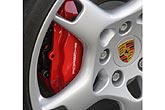Recent Articles
Popular Makes
Body Types
2007 Porsche Boxster First Drive
Performance tweaks result in a better Boxster
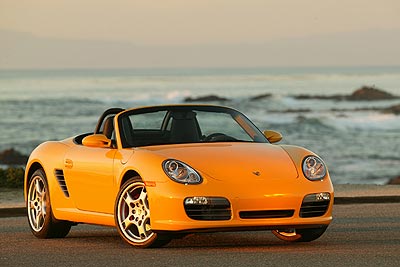
Porsche Boxster – First Drive: We had so much fun driving the 2007 Porsche Boxster – two hours on one of the finest roads in America – it felt like adultery. Though we have no experience with infidelity, we’re guessing the range of emotions we experienced while pressing the new, more powerful Boxster on a sublime ribbon of Tennessee asphalt was akin to an illicit afternoon in a swanky hotel room: spine-tingling anticipation, extreme elation, dank fear, and then guilt. We started our day in a 2007 Boxster S fitted with a new six-speed Tiptronic auto-manual transmission. As we loafed it toward Tennessee’s tantalizing Cherohala Skyway we could sense the added performance of the larger 3.4-liter, 295-horsepower engine, and it was like a summons to our foolish blood. Then, once we arrived at the road’s start near Robbinsville, we opened it up and the knife-edged mountains on either side of us rang with our whoops and screams. The idea of our tryst being interrupted by a gun-toting chaperone in a cruiser made us pucker and wilt for a minute, but we abandoned our inhibitions to the heat of the moment. Afterward we felt some guilt at having so much fun that it hardly seemed fair or right when so many people must drive boring cars. That too, however, was temporary because we went right out again in a regular Boxster with a five-speed manual. You know what they say: Once a cheater, always a cheater.
Engine Upgrades
Engine Upgrades Thanks to an infusion of extra power, and in the S model using the same engine that is offered in the Porsche Cayman S, the 2007 Boxster is better than ever before. When the Porsche Boxster debuted in 1997 it had a 201-horsepower, 2.5-liter horizontally-opposed “boxer” engine. Ten years later, the 2007 model boasts a 2.7-liter boxer engine pushing 245 horsepower, up five horsepower from 2006. And torque, which we all know is the real indication of a car’s ability to haul ass, is up to 201 lb.-ft. between 4,600 and 6,000 rpm, an increase of two lb.-ft. from last year. Modest gains to be sure, but gains nonetheless. The new Boxster is now less a slightly wimpy roadster and more a bona fide Porsche sports car. A good indicator of how much the regular-strength Boxster has improved is that it has only five horsepower less than the original Boxster that arrived in 2000. Already one of the best roadsters in its class, the Boxster S is now even better with the addition of the same 295 horsepower, 3.4-liter powerplant used in the Cayman S. Think of it as a convertible Cayman, which is a very good thing indeed. The 2007 Boxster S gains 15 horsepower and 15 lb.-ft. of torque from last year’s model, which is like adding more muscle and more speed to New Orleans’ already quick and talented running back Reggie Bush – the idea’s just plain exciting. Gains in both engines were made via tweaks to the engine design and by adding the same VarioCam Plus technology that’s used in the Porsche 911 and Cayman S. VarioCam Plus is like having a miniature accountant in the engine. He’s constantly monitoring airflow and making adjustments to the cams and valves to insure there’s no waste and that maximum power is the bottom line. In addition, the crankshaft in the 2.7-liter regular Boxster engine is lighter than the previous model’s and the holes in the hollow piston pins are larger for even more weight savings. The lighter weight makes the vehicle faster and more responsive. Coolant flow has also been improved, which reduces the risk of engine knock and improves the compression ratio, so that the base Boxster actually has a better compression ratio than the Boxster S. The most enjoyable benefit of these improvements is the engine’s broad torque band and its ability to deliver maximum power all the way from 4,600 rpm to 6,000 rpm. Porsche claims the new Boxster goes 0 to 60 mph in 5.8 seconds, has a top speed of 160 mph, and still manages an impressive 23 mpg in the city and 32 mpg on the highway. During our sweet, stolen afternoon with the Boxster we can attest to its improved performance, but our screaming around in third gear near redline for most of the time played havoc with our mileage. Love hurts. Though the 3.4-liter engine in the Boxster S has the same external dimensions as the 2.7-liter engine, it’s what’s inside that counts. The 3.4-liter engine has larger pistons for more airflow and combustion and thus more power. Many of its working parts are identical to those used in the 911 Carrera – good enough for a 0 to 60 time of 5.1 seconds and a top speed of 169 mph. Those are bodacious specifications and downright libidinous when you let them out on a road like the Cherohola Skyway.
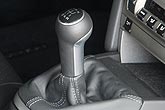
Transmission
Transmission Choose between the Porsche Boxster and the Porsche Boxster S – the main differences lie in power, torque, and performance tweaks that make the pricier S model the better of the two. By now you know that you have a choice between the base Boxster and the Boxster S, between 245 and 295 horsepower, and between 0-60 times of 5.8 and 5.1 seconds, respectively. However, there are a few more differences, not least of which is the price: $46,395 for the base Boxster and $56,295 for the Boxster S (including $795 destination charge). The base model comes standard with a five-speed manual transmission that gets the job done, but when you’re spooling the car out over a really great road, you can’t help but wish there was one more gear, just a little more oomph. But, as we already noted, the sweet spot in the 2.7-liter engine is so big, a lot of the time we just left the shifter in third and let the engine do the work. This was especially true on the nearby Tail of the Dragon – a highway in the Great Smoky Mountains of Tennessee and North Carolina with 318 turns in its 11-mile length. The hairpins and cutbacks came so fast and furious we didn’t really have time to shift. However, the six-speed manual that’s standard on the S is a sweet affair. Like all Porsche shifters, it’s as precise as the action on a well-oiled rifle and we appreciated the extra gear on the Cherohola, which has fewer turns and more time to work up and down the gears to indulge our Steve McQueen fantasies. The five-speed Tiptronic S auto-manual transmission is available for both models ($3,210), making electronically perfect shifts via controls on the steering wheel much faster than we could ever hope to. We tried the Tiptronic in a loaded Boxster S and appreciated how it freed us to concentrate on steering and keeping the car on the road, but we weren’t crazy about how it took over shifting for us sometimes during less aggressive driving when we wanted to hold a gear and it wanted to go immediately to fifth or sixth. We also, perhaps because of our Steve McQueen delusions, think it’s more fun to have total control of a car like the Boxster. We loved Tiptronic when we drove the 2007 Porsche 911 Turbo, for example, because that car’s power is so prodigious we welcomed all the help we could get in controlling it. Porsche says that Tiptronic works best when combined with the optional Sport Chrono Package ($920) because it shifts gears more quickly and holds gears longer against the redline limiter. It also reduces the intervention of the Porsche Stability Management (PSM – standard on all cars) to allow a little more wheel slippage, like when you’re accelerating out of a turn and the back end comes out a little bit and then snaps back when you stomp on the gas – way, way cool. The package also includes a stop watch in a binnacle on top of the dash that looks nifty, but we can’t imagine using it.
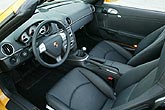
Features
Features Whether Boxster or Boxster S, each Porsche comes equipped to drive with a few select luxury and custom extras. Differences between the base Porsche Boxster and the Porsche Boxster S lay primarily in the powertrains. The Boxster S is more powerful, and it comes with a standard six-speed manual transmission as opposed to the five-speed gearbox on the base model. The Boxster S also boasts slightly larger front brakes (12.52 inches in diameter compared to the base car’s 11.73-inch discs) to compensate for its greater power, and gets 18-inch wheels and tires instead of the Boxster’s standard 17-inch rims and rubber. However, both look and perform better with the optional 19-inch wheels ($3,175 for the base and $1,940 for the S). Finally, high-performance Porsche Ceramic Composite Brakes ($8,150), valued for their light weight and fade resistance, are only available on the Boxster S. Though each car comes well equipped right out of the box, Porsche buyers want to give their new dream car a custom look or specification, so there is a long list of options available. Among the most popular add-ons are metallic paint ($825); a navigation system ($2,970); a Bose surround sound audio system ($1,665); a full leather interior ($2,095); and our Guards Red Boxster S test car was equipped with matching red seat belts ($340) that added a dashing, race-car touch. If we were ordering a Boxster, we’d include the Sport/Porsche Active Suspension Management setup ($2,680) because it has the greatest effect on driving dynamics and our fun factor. First introduced on the 911 Carrera in 2005, PASM provides two suspension choices: “Normal” and “Sport.” The system takes readings from sensors that monitor steering, speed, brakes, vertical movement, and engine torque and then continuously adjusts the shock absorbers for optimum balance and control. When Sport is selected, the difference is immediately noticeable, with a more solid feel, better turn in, more immediate braking and even less body roll than when in Normal mode (which isn’t much). It’s like the difference between skating on slightly dull blades versus super sharp ones.
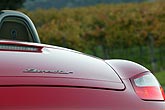
Driving Impressions
Driving Impressions In many ways, the Porsche Boxster is more fun to drive than its more powerful and expensive sibling in the lineup, the 911 Carrera. Yet, just because it’s designed to fulfill the mission of a sports car, the Boxster is just as good in the city and on the highway. An old Ford pickup slowed to look at our flashy red German sports car, the pickup’s homemade camouflage paint job melding with the rural Tennessee roadside. The driver pushed his foam and mesh trucker’s cap back on his head and stared. We didn’t stick around for a chat, but we thought his look said “These roads are for driving, boys, not driving.” Besides, we were having too much fun to care. Driving this classically-inspired, modern roadster confirms what its looks suggest – it’s a road-eating machine whose sole purpose is to thrill, though the Boxster and Boxster S don’t have scary power to make you feel like the next turn taken too quickly might be your last (its big brother the 911 Carrera can inspire that fear). The Boxster is just fast enough so that if you go hard into a corner, taking full advantage of its superb road-holding abilities, and then step hard on the gas the effect is totally exhilarating. There aren’t many cars on the road that incorporate the driver so wholly into the experience that the machine feels like an extension of your body: turn your hands and the car turns, press down your foot and it speeds forward without a moment of hesitation. Plus, you can even feel if the road surface changes from smooth to slightly pebbly or even sandy. This level of involvement increases your confidence and enjoyment exponentially. We even felt comfortable switching off the electronic wizardry of Porsche’s Stability Management, which uses ABS (antilock brakes), ASC (anti-slip, or stability, control), EDC (engine drag control), and ABD (automatic brake differential) to help keep the car from sliding and going off-course. At first we were fearful, because on a road like the Cherohola, bad things can happen quickly. But we found the level of control and confidence the Boxster provides compensated for the lack of electronic intervention. In fact, instead of being scared of ending up in the woods, we thoroughly enjoyed the extra wheel spin and the over- and understeer that not using PSM allowed. Adding to our experience was the Boxster’s intoxicating exhaust note, which was like a theme song for our afternoon of . Above 4,000 rpm the exhaust builds to a crescendo – BLENNNNN! – before you shift gears, release the clutch, and wind it up again. The Boxster isn’t all high-octane thrills, though; its ride is compliant and comfy enough to pleasurably cruise even bumpy roads and the adaptable transmission allows you to race around at 65 mph in second gear or amble along at 35 mph in fourth. And the cabin, even with the top down, is surprisingly serene – normal conversation with your passenger is possible. The optional ($375) wind deflector that fits between the headrests plays a large role in suppressing wind noise. The seats are similarly changeable: during spirited driving they feel like custom race buckets, but they’re spacious and comfy on long hauls, too. There’s also enough cargo space (nearly ten cubic feet total) for a weekend’s worth of luggage for two. Which is perfect, because then you can take your spouse with you and enjoy the car with a totally clear conscience.
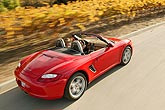
FAQs
FAQs The 2007 Porsche Boxster hit dealerships in August of 2006, looking just like last year’s car but infused with added power – including a 295-horsepower 3.4L engine from the Cayman S. When can I get a 2007 Porsche Boxster? The 2007 Porsche Boxster and Boxster S went on sale this August. Do the 2007 Boxster and Boxster S have the same engine as the Porsche Cayman? Only the 2007 Porsche Boxster S has the same 295 horsepower, 3.4-liter powerplant used in the Cayman S. Are there any styling changes to the new Boxster and Boxster S? No, both models received a near total re-freshening in 2005, when 80 percent of the parts and components changed and the interior was made more modern, comfortable and attractive. The exterior only received minor tweaks and remains very similar to the original car that debuted in 1997.
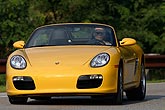
Boxster Specifications
Boxster Specifications Competitors for the 2007 Porsche Boxster include the Audi TT, BMW Z4, and the Mercedes-Benz SLK-Class. Test Vehicle: 2007 Porsche Boxster Base Price: $46,395 (including the $795 destination charge) Engine Size and Type: 2.7-liter horizontally-opposed “Boxer” six-cylinder Engine Horsepower: 245 at 6,500 rpm Engine Torque: 201 lb.-ft. between 4,600 and 6,000 rpm Transmission: Five-speed manual or six-speed automatic with Tiptronic manual shift feature Curb Weight, lbs.: 2,877 (3,009 with automatic) EPA Fuel Economy (city/highway): 23/32 mpg Length: 171.6 inches Width: 70.9 inches Wheelbase: 95.1 inches Height: 50.9 inches Legroom: 41.6 inches Headroom: 38.4 inches Max. Seating Capacity: Two Max. Cargo Volume: 5.3 cubic feet front and 4.6 cu.-ft. rear Competitors: Audi TT, BMW Z4, Chevrolet Corvette, Chrysler Crossfire SRT-6, Honda S2000, Nissan 350Z, Mercedes-Benz SLK-Class
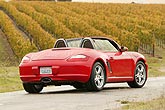
Boxster S Specifications
Boxster S Specifications Competitors for the 2007 Porsche Boxster S include the BMW Z4 M Roadster, Chevrolet Corvette, Chrysler Crossfire SRT-6, Mercedes-Benz SLK55 AMG Test Vehicle: 2007 Porsche Boxster S Base Price: $56,295 (including the $795 destination charge) Engine Size and Type: 3.5-liter horizontally-opposed “Boxer” six-cylinder Engine Horsepower: 295 at 6,250 rpm Engine Torque: 252 lb.-ft. between 4,000 and 6,000 rpm Transmission: Six-speed manual or six-speed automatic with Tiptronic manual shift feature Curb Weight, lbs.: 2,987 (3,075 with automatic) EPA Fuel Economy (city/highway): 20/28 mpg Length: 171.6 inches Width: 70.9 inches Wheelbase: 95.1 inches Height: 50.9 inches Legroom: 41.6 inches Headroom: 38.4 inches Max. Seating Capacity: Two Max. Cargo Volume: 5.3 cubic feet front and 4.6 cu.-ft. rear Competitors: BMW Z4 M Roadster, Chevrolet Corvette, Chrysler Crossfire SRT-6, Mercedes-Benz SLK55 AMG
Photos courtesy of Porsche cars North America
